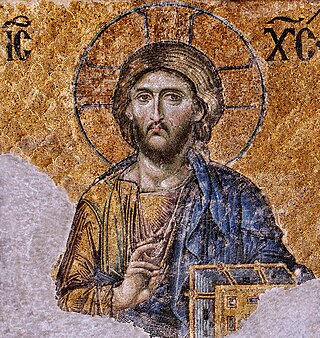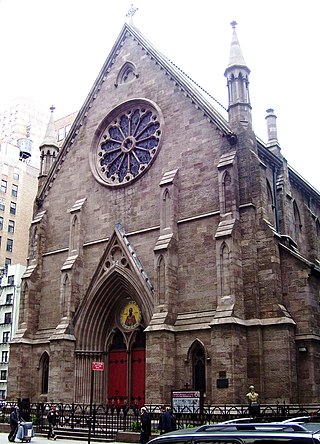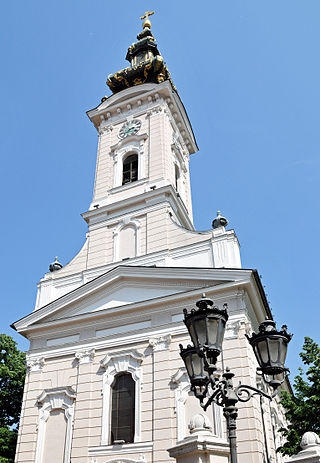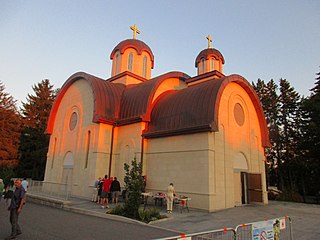
Gaborone is the capital and largest city of Botswana with a population of 246,325 based on the 2022 census, about 10% of the total population of Botswana. Its agglomeration is home to 421,907 inhabitants at the 2011 census.

Nikolaj Velimirović was bishop of the eparchies of Ohrid and Žiča (1920–1956) in the Serbian Orthodox Church. An influential theological writer and a highly gifted orator, he was often referred to as the new John Chrysostom and historian Slobodan G. Markovich calls him "one of the most influential bishops of the Serbian Orthodox Church in the twentieth century".

The Serbian Orthodox Church is one of the autocephalous Eastern Orthodox Christian churches.

The Temple of Saint Sava is a Serbian Orthodox church which sits on the Vračar plateau in Belgrade, Serbia. It was planned as the bishopric seat and main cathedral of the Serbian Orthodox Church. The church is dedicated to Saint Sava, the founder of the Serbian Orthodox Church and an important figure in medieval Serbia. It is built on the presumed location of St. Sava's grave. His coffin had been moved from Mileševa Monastery to Belgrade. The coffin was placed on a pyre and burnt in 1595 by Ottoman Grand Vizier Sinan Pasha. Bogdan Nestorović and Aleksandar Deroko were finally chosen to be the architects in 1932 after a second revised competition in 1926–27. This sudden decision instigated an important debate in interwar Yugoslavia which centered around the temple's size, design and symbolic national function. This was accompanied by a sizeable increase in the base area of the ambitiously conceived project. The new design departed from the competition guidelines issued in 1926, and was to replicate the dimensions and architecture of Hagia Sophia.

Serbian Americans or American Serbs, are Americans of Serb ethnic ancestry. As of 2013, there were about 190,000 American citizens who identified as having Serb ancestry. However, the number may be significantly higher, as there were some 290,000 additional people who identified as Yugoslavs living in the United States.

The community of Serbian Canadians includes Canadian citizens of Serb ethnicity, or people born in Serbia who permanently reside in Canada. Serbs have migrated to Canada in various waves during the 20th century. Today there are five or more generations of Serbs in the country. The 2016 census recorded 96,530 people in Canada declaring themselves as "Serbian". Serbian Canadians generally belong to the Serbian Orthodox Church and follow the Eastern Orthodox tradition.

Religious architecture in Novi Sad is very diverse. Majority of the believers in Novi Sad are from Serbian Orthodox Church, while others are from Roman Catholic Church, many Protestant churches, and Jewish community. Stari Grad is the place with the majority of churches and temples, and they were all built in the 18th and 19th century.

The Trinity Chapel Complex, now better known as the Serbian Orthodox Cathedral of St. Sava is a historic Eastern Orthodox church at 15 West 25th Street between Broadway and the Avenue of the Americas in the NoMad neighborhood of Manhattan, New York City.

Saint Sava, known as the Enlightener, was a Serbian prince and Orthodox monk, the first Archbishop of the autocephalous Serbian Church, the founder of Serbian law, and a diplomat. Sava, born as Rastko Nemanjić, was the youngest son of Serbian Grand Prince Stefan Nemanja, and ruled the appanage of Zachlumia briefly in 1190–92. He then left for Mount Athos, where he became a monk with the name Sava (Sabbas). At Athos he established the monastery of Hilandar, which became one of the most important cultural and religious centres of the Serbian people. In 1219 the Patriarchate exiled in Nicea recognized him as the first Serbian Archbishop, and in the same year he authored the oldest known constitution of Serbia, the Zakonopravilo nomocanon, thus securing full religious and political independence. Sava is regarded as the founder of Serbian medieval literature.

The Saint Sava Serbian Orthodox Church is a Serbian Orthodox church in Jackson, California. Built in 1894, the church was the first Serbian Orthodox church in America. Amador County had a large Serbian-American population in the late 1800s due to the California Gold Rush, and the county's Serbs established the St. Sava Church Organization of Amador County in 1886–87; the organization was responsible for purchasing land for and building the church, and the effort was led by Sevastijan Dabović. The church's original design had an Eastern Orthodox influence, complete with an onion dome; while the dome was later replaced by a bell tower, the church's stained glass windows and use of icons still give it a distinctive Eastern Orthodox character. The church has been used for Serbian-American religious and social activities since its opening and is now part of the Serbian Orthodox Eparchy of Western America.
White people in Botswana are Botswanan people whose ancestry lies within the continent of Europe, most notably the United Kingdom and the Netherlands.

The St. Sava Serbian Orthodox Cathedral is a large Serbian Orthodox Cathedral located in Milwaukee, Wisconsin. Completed in 1956, the cathedral is covered in traditional wall mosaics that have been described as, "some of the most extensive and elaborate church mosaics in the United States." The cathedral sits on a complex that also includes a parochial school and an event center known as the American Serb Hall, an important stop for political candidates including a number of men who have gone on to become President of the United States.
Serbian South African is a South African citizen of Serbian descent or Serbia-born person who resides in South Africa.

The Saint Sava Serbian Orthodox Church is a church building in Enskede gård in Stockholm, Sweden. It was taken into use in 1991 but not officially inaugurated until 5 October 2014. It is the cathedral church of the Serbian Orthodox Eparchy of Britain and Scandinavia.

The Serbian Orthodox Church in North and South America is a constituent and integral part of the one and only Serbian Orthodox Church (Patriarchate) and therefore the jurisdiction of the Serbian Orthodox Church (SPC) in the Americas. It has five eparchies (dioceses), that were reorganized in 2009. It also has a central church council made up of diocesan bishops, and almost 220 churches, chapels, monasteries and sketes in the United States, Canada, and South and Central America.

The Saint Sava Serbian Orthodox Church was originally established February 14, 1914, in Gary, Indiana, US, and is now located in Merrillville, Indiana, after the consecration of the new church building in 1991. It is the church-school congregation in which Saint Varnava, the first American-born Serbian to be proclaimed an Orthodox saint, was baptized, served as altar boy, and was first recognized as a youthful prodigy in reciting Serbian folklore and old ballads.

Saint Michael the Archangel Serbian Eastern Orthodox Church in Toronto, Ontario, Canada is a Serbian Eastern Orthodox church which is not a member of the Serbian Orthodox Church due to a tumultuous history.

Saint Sava Serbian Orthodox Church is a Serbian Orthodox church located in the Cabbagetown neighbourhood of Toronto, Ontario, Canada.

Saint Arsenije Sremac Serbian Orthodox Church is a Serbian Orthodox church located in Whitby, Ontario, Canada.

St. Stefan Serbian Orthodox Church (Ottawa), part of the Serbian Orthodox Eparchy of Canada, is located at 1989 Prince of Wales Drive in Nepean (Ottawa), the home of the Ottawa Serbian Church School Congregation and Community centre.

















